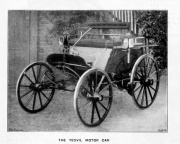Yeovil Motor Carriage Co: Difference between revisions
No edit summary |
|||
| Line 9: | Line 9: | ||
==The Yeovil Car in 1897== | ==The Yeovil Car in 1897== | ||
The Yeovil motor car was a light business carriage for two persons. It was driven by a two-cylinder | The Yeovil motor car was a light business carriage for two persons. It was driven by a two-cylinder | ||
Petter patent | Petter patent engine working on the Otto cycle, using ordinary petroleum. The cylinders were arranged side by side, and fired alternately. The explosions were effected by means of two ignition tubes, heated by a single blow lamp. The air inlet valves of the motor were operated by the suction of the piston, the exhaust valves by means of levers driven by chain gearing from the crank shaft. There was a choice of 2 gear ratios, providing fast and slow speeds of ten and four miles respectively. The rear | ||
axle drove one of the rear wheels of the carriage. A brake was held on the fly-wheel by a spring to control tbe engine when the carriage was at rest. When the carriage was in motion this brake was held off by a hand lever. Two pairs of ordinary carriage brakes were applied to the rear wheels, and the reversing mechanism provided a strong additional brake in case of emergency<ref>[[The Engineer 1897/06/04]]</ref> | |||
axle | |||
== See Also == | == See Also == | ||
<what-links-here/> | <what-links-here/> | ||
Revision as of 18:45, 1 August 2012

See Petters.
1897 Making small motor carriages for two [1]
1897 Yeovil Motor Car and Cycle Co was one of 4 companies which offered vehicles for trials organised by the Engineer magazine at Chelsea [2].
The Yeovil Car in 1897
The Yeovil motor car was a light business carriage for two persons. It was driven by a two-cylinder Petter patent engine working on the Otto cycle, using ordinary petroleum. The cylinders were arranged side by side, and fired alternately. The explosions were effected by means of two ignition tubes, heated by a single blow lamp. The air inlet valves of the motor were operated by the suction of the piston, the exhaust valves by means of levers driven by chain gearing from the crank shaft. There was a choice of 2 gear ratios, providing fast and slow speeds of ten and four miles respectively. The rear axle drove one of the rear wheels of the carriage. A brake was held on the fly-wheel by a spring to control tbe engine when the carriage was at rest. When the carriage was in motion this brake was held off by a hand lever. Two pairs of ordinary carriage brakes were applied to the rear wheels, and the reversing mechanism provided a strong additional brake in case of emergency[3]
See Also
Sources of Information
- ↑ The Autocar. 26th September 1897
- ↑ The Engineer 1897/06/04
- ↑ The Engineer 1897/06/04

